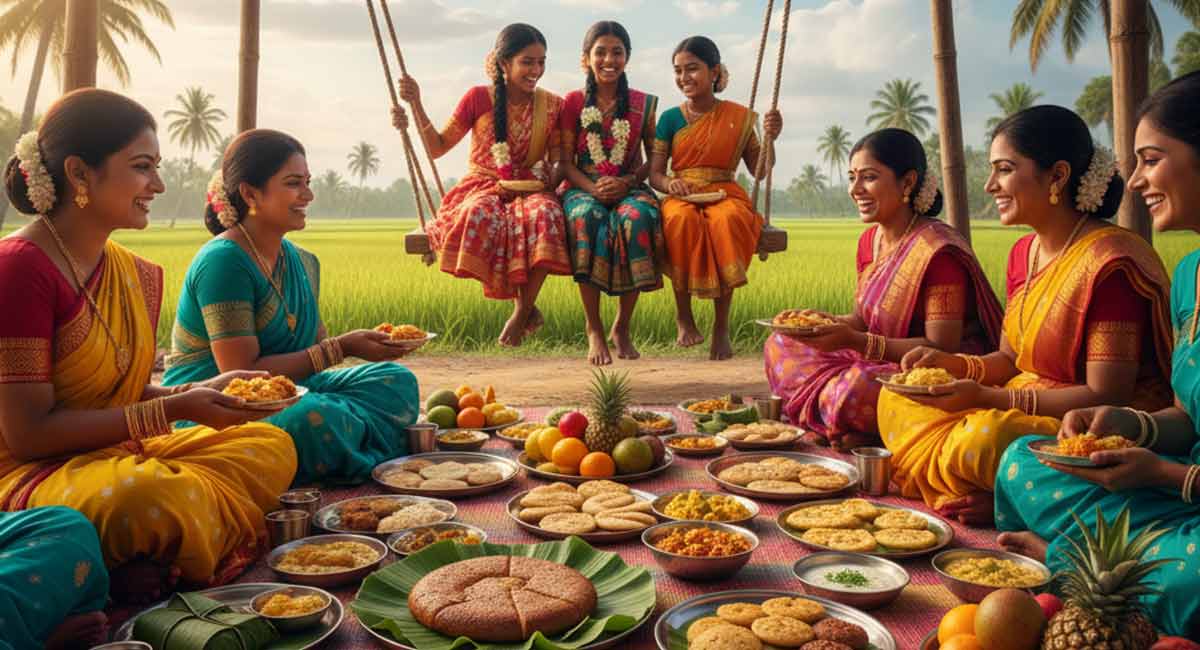The Vibrant Palette of Food During Raja Festival
The Raja Festival, pronounced as Raw-jaw, is one of Odisha’s most vibrant and beloved celebrations, symbolizing womanhood, fertility, and the arrival of the monsoon. People celebrate the festival over three days-Pahili Raja, Raja Sankranti, and Basi Raja-with rituals, merrymaking, swings, and, most importantly, food. Among the culinary stars of this joyous time are Pithas, Panasa (jackfruit) dishes, and the indulgent Coconut Sweets that adorn every Odia household’s festive menu.
This blog examines the deep-rooted food traditions that make the Raja Festival a unique culinary affair.
The Cultural Essence of Raja and Its Food
Raja Parba is primarily a celebration of menstruating women, aligning the Earth’s fertility with that of a woman’s. During these three days, women refrain from physical work, apply alta on their feet, wear new clothes, and enjoy swings (doli) while savoring delicious seasonal foods.
The festival also celebrates seasonal bounty-fruits like mangoes, jackfruit, and pineapples are abundant, as are fresh vegetables and grains. And at the heart of it all lies the preparation of traditional Odia delicacies, passed down through generations.
Pithas: The Soul of Raja Cuisine
No Raja Festival is complete without Pithas, Odisha’s version of rice cakes, which come in various forms-steamed, fried, baked, and even roasted. They are both savory and sweet, but the sweet ones hold a special place during the festival.
- Podapitha: A smoky, slightly crusty rice cake made with rice flour, jaggery, grated coconut, and a touch of black pepper. Traditionally, people bake it over low heat in clay ovens or on a chulha (wood-fired stove), which imparts a rustic flavor. People usually prepare Podapitha on the eve of Pahili Raja and enjoy it throughout the festival.
- Arisa Pitha: This deep-fried rice cake has a crispy exterior and a chewy, sweet interior. Arisa Pitha is an offering to gods and guests made with fermented rice flour and jaggery.
- Manda Pitha: A steamed delight filled with coconut and jaggery, encased in a soft rice dough. This pitha symbolizes festivity and purity, steamed to perfection in banana leaves for a delicate aroma.
- Chakuli Pitha: A thin, crepe-like dish made with fermented rice and black gram batter, usually served with jaggery syrup or curry. Typically, a typical breakfast in Odia households, its lighter version became popular during the Raja.
Each of these pithas holds a story and a memory, lovingly prepared by grandmothers and mothers, often in community gatherings.
Panasa – The Jackfruit Connection
The arrival of summer also signals the ripening of Panasa (jackfruit), a fruit cherished in Odisha not just for its sweet pulp but also for its raw, meaty texture that’s ideal for cooking.
- Panasa Tarkari (Raw Jackfruit Curry): Often called “vegetarian meat,” raw jackfruit is cut into chunks and simmered in a spicy mustard or tomato-based curry. Cooked with potatoes and traditional spices like panch phoron (five-spice blend), this dish is rich, hearty, and usually served with steamed rice or Chakuli Pitha.
- Panasa Chhena Poda: This innovative dessert combines grated ripe jackfruit with chhena (cottage cheese) and jaggery to make a baked sweet that fuses fruity and creamy textures.
- Ripe Panasa as Dessert: The sweet, golden bulbs of ripe jackfruit are often served as-is or with a sprinkle of salt and black pepper. Some households also mix the pulp with coconut and jaggery to create a filling for pithas or as a side accompaniment.
Jackfruit is more than a fruit during Raja-it symbolizes abundance and celebration.
Coconut Sweets – Sweet Delight
Raja cuisine features coconut, or nadia, as people call it in Odia, as a staple ingredient. Its versatility lends itself beautifully to savory and sweet dishes, but it truly shines in desserts.
- Nadia Ladoo (Coconut Ladoo): These delightful yet straightforward balls are made by slow-cooking grated coconut with jaggery or sugar until it forms a sticky mixture. Flavored with cardamom and shaped into bite-sized ladoos, they are a favorite treat for children and adults alike.
- Poda Nadia (Caramelized Coconut): In this dish, grated coconut is slow-roasted with jaggery until it develops a deep brown hue and caramelized flavor. Often served as a side or eaten plain, it’s comforting and deeply satisfying.
- Coconut Stuffed Pithas: Manda and Kakara Pithas filling during Raja usually features fresh coconut sautéed with jaggery and flavored with cardamom, providing a chewy and aromatic center that balances the dough’s softness.
Why Raja Food Matters?
Beyond its deliciousness, the food of Raja Festival reflects the deeper values of Odia culture: respect for nature, seasonal eating, and reverence for femininity. Preparing pithas is more than just cooking-it’s a bonding ritual where women and girls come together, sharing stories and laughter as they shape each delicacy by hand.
Moreover, the ingredients used-jackfruit, coconut, rice, and jaggery-are all naturally available and symbolize prosperity, sweetness in relationships, and sustainability. Eating seasonally and locally during Raja also supports better health and promotes harmony with the environment.
Final Thoughts
Food is a significant factor in making the Raja Festival a fantastic feast for the senses. Whether it’s the smoky bite of Podapitha, the meaty richness of Panasa Tarkari, or the melt-in-your-mouth sweetness of coconut ladoos, each dish is a tribute to Odisha’s culinary heritage.
So, the next time you hear the swings creak and see alta-stained feet twirl in joy, remember that somewhere nearby, someone lovingly serves a plate of warm pitha and a bowl of jackfruit curry, bringing people together through tradition, taste, and timeless celebration.


